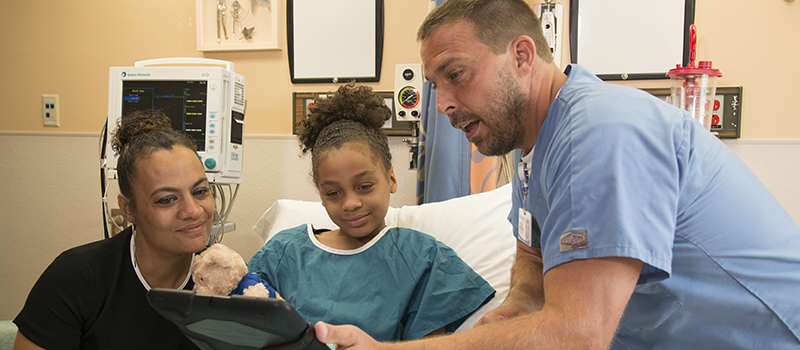
Beaumont Children’s is among a handful of children’s hospitals to provide robotic-assisted laparoscopic surgery, in addition to traditional laparoscopic surgery, and one of a few pediatric centers in the country performing routine procedures
with the robot, in children of virtually any age.
What is robotic surgery?
The robot device enhances the physical abilities of the surgeon. The robot helps extend the dexterity, reach and visualization of the surgeon. The robot arms reflect the exact movements of the surgeon in real time but with much greater precision, allowing for smaller incisions and scarring.
Minimally invasive surgery provides less pain, faster return to activities and school, shorter stays in the hospital, less external and internal scarring and often a superior cosmetic result.
Benefits of pediatric robotic surgery
The benefits of robotic surgery include, but are not limited to:
- better dexterity for delicate procedures and small patients
- enhanced visual field, often allowing visualization of adjacent structures which may not be visible in the respective standard open technique
- instruments with expanded range of motion
- 3-D imaging of the surgical site
- stabilization, which removes any instability in human hands
- smaller incisions and better cosmetic result
- less pain and trauma
- shorter recovery times and hospital stays
Is robotic surgery right for my child?
Robotic-assisted minimally invasive surgery is offered for select conditions at Beaumont Children’s. While it has many advantages, there are some challenges. Robotic-assisted surgery may not be suitable to every minimally invasive procedure. Your
surgeon will help you understand if utilizing the robot is an appropriate choice for your child’s condition.
What kind of procedures can be performed with the robot?
The following procedures can be performed with robotic-assisted surgery:
- adrenalectomy – adrenal gland removal
- choledochal cyst excision
- cholecystectomy – gallbladder removal
- colectomy with pull through – colon removal
and reconstruction
- esophageal resection
- Heller myotomy – treatment for achalasia
- kidney removal (nephrectomy)
- MACE procedure
- Morgagni hernia repair
- Nissen fundoplication – esophageal reflux surgery
- ovarian cyst/tumor removal
- pancreas resection
- partial nephrectomy
- pyloroplasty
- removal of pelvic organ(s) and reconstruction
- splenectomy – spleen removal
- ureteral reconstruction, uretero-ureterostomy
- Mitrofanoff (appendicovesicostomy)
- vretroperitoneal lymph node dissection
- urachal cyst/anomaly excision
- ureteropelvic junction (UPJ) obstruction/hydronephrosis – pyeloplasty
- vesicoureteral reflux (VUR) –ureteral reimplantation
- varicocelectomy